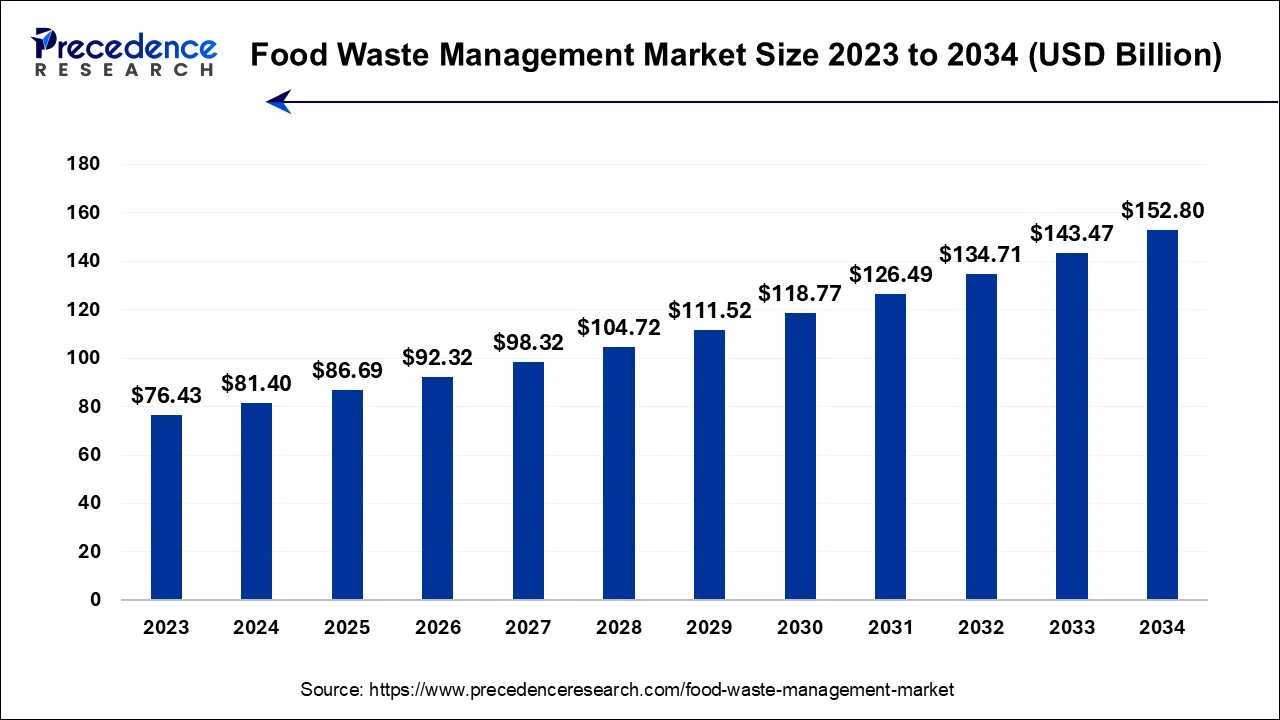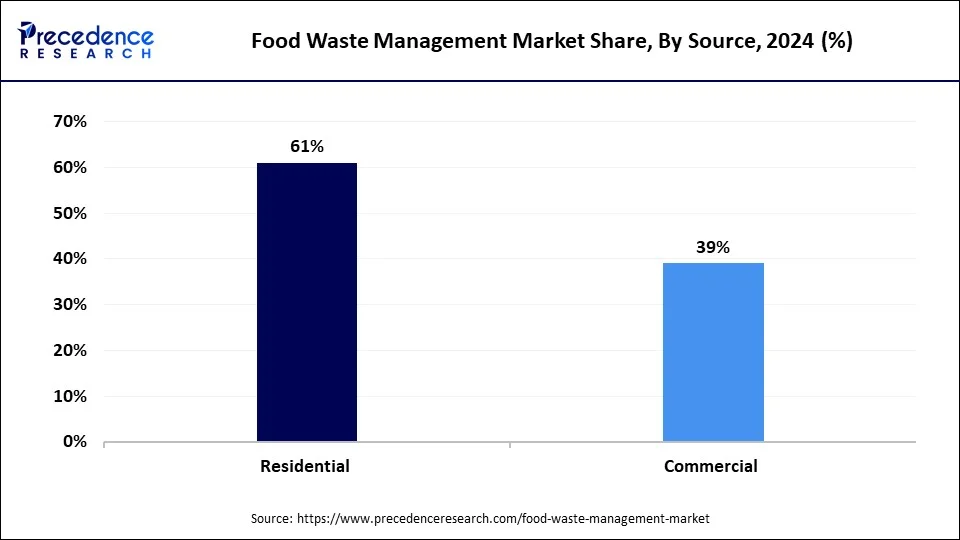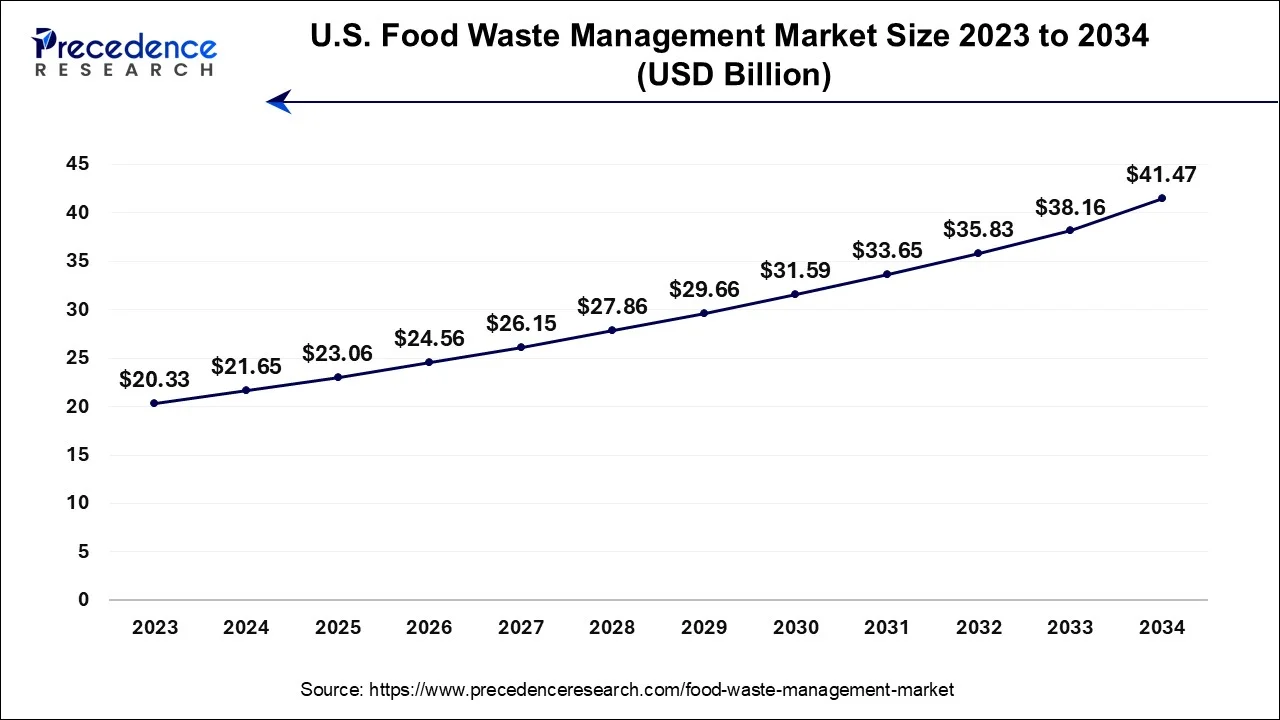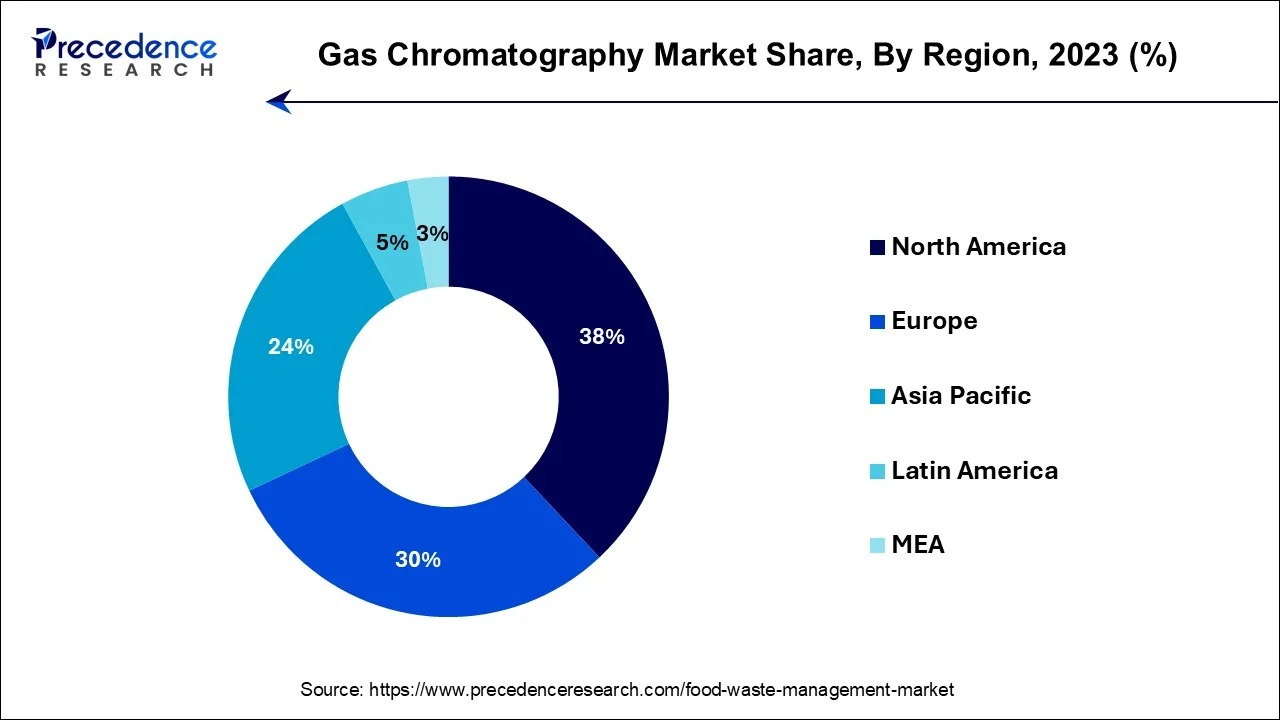List of Contents
What is Food Waste Management Market Size?
The global food waste management market size accounted for USD 86.69 billion in 2025 and is anticiipated to reach around USD 152.80 billion by 2034, expanding at a CAGR of 6.50% between 2025 and 2034.

Market Highlights
- North America contributed more than 38% of revenue share in 2023.
- Asia Pacific is estimated to expand at the fastest CAGR between 2025 and 2034.
- By Waste Type, the fruits & vegetables segment held the largest market share of 24% in 2024.
- By Waste Type, the dairy & dairy products segment is anticipated to grow at a remarkable CAGR of 7.8% between 2025 and 2034.
- By Source, the residential segment generated over 61% of revenue share in 2024.
- By Source, the commercial segment is expected to expand at the fastest CAGR over the projected period.
- By Service Type, the collection segment had the largest market share of 53% in 2024.
- By Service Type, the disposal/recycling segment is expected to expand at the fastest CAGR over the projected period.
Market Overview
The foodwaste management marketplays a pivotal role in addressing the escalating global issue of food wastage. It involves efficiently collecting, disposing, and recycling food waste generated across diverse sectors. This market's growth is fueled by several drivers, including increase in environmental awareness, stringent regulations promoting responsible waste disposal, and the need to reduce greenhouse gas emissions associated with food decomposition. Moreover, the shift towards a circular economy and the focus on resource conservation are driving forces behind this industry's expansion.
The food waste management market is at the forefront of sustainability efforts, striving to reduce the environmental impact of food waste while offering potential growth avenues for companies and entrepreneurs committed to combating this critical global issue.
Food Waste Management Market Growth Factors
- The food waste management market focuses on the efficient collection, disposal, and recycling of food waste across various sectors.
- Drivers of market growth include increasing environmental awareness, strict regulations, and the need to reduce greenhouse gas emissions.
- The shift towards a circular economy and resource conservation further fuels industry expansion.
- Challenges include significant infrastructure investments, complex waste segregation, and high costs of recycling technologies.
- These challenges create opportunities for innovation and technology development in the food waste management sector.
- The market plays a vital role in addressing global food wastage issues and promotes sustainability efforts.
- International cooperation and agreements on food waste reduction are driving the standardization of waste management practices.
- Innovative approaches, such as community composting and smart waste collection systems, are emerging as solutions to streamline food waste management processes and minimize environmental impact.
Food Waste Management Market Outlook: A Path Towards A Clear Future
- Industry Growth Overview: The stringent government regulations, growing corporate sustainability initiatives, and technological advancements contribute to the industrial growth of the market.
- Major Investors: Large financial institutions, strategic corporate investors, and venture capital funds are the major investors in the market.
- Startup Ecosystem:The startup ecosystem is focusing on using advanced technologies and circular economy principles.
Market Scope
| Report Coverage | Details |
| Market Size in 2025 | USD 86.69 Billion |
| Market Size in 2026 | USD 92.32 Billion |
| Market Size by 2034 | USD 152.80 Billion |
| Growth Rate from 2025 to 2034 | CAGR of 6.50% |
| Largest Market | North America |
| Base Year | 2024 |
| Forecast Period | 2025 to 2034 |
| Segments Covered | Waste Type, Source, Service Type, and Region |
| Regions Covered | North America, Europe, Asia-Pacific, Latin America, and Middle East & Africa |
Market Dynamics
Drivers
Growing environmental awareness and stringent regulatory framework
This recognition that food waste is a substantial contributor to greenhouse gas emissions and resource depletion has intensified the urgency to combat the problem. This heightened environmental consciousness is spurring the widespread adoption of food waste management solutions. Individuals, businesses, and governments alike are now taking proactive measures at every stage of the supply chain, from individual households to large food producers. This collective effort is aimed at mitigating the environmental impact of food waste and fostering more sustainable waste management practices.
Moreover, stringent regulations and policies have been enacted worldwide to curb food waste. Governments and local authorities are implementing measures that mandate responsible food waste disposal, imposing fines for non-compliance. These regulations create a legal imperative for businesses and institutions to adopt effective food waste management practices, driving the demand for innovative solutions. In this environment, the food waste management market plays a crucial role in providing the expertise and infrastructure needed to meet both environmental goals and legal requirements.
Restraint
Complex waste segregation and limited infrastructure
Complex waste segregation and limited infrastructure pose significant challenges to the food waste management market. While there is a growing awareness of the need to manage food waste sustainably, the practical implementation of effective segregation remains a hurdle. Food waste can be highly heterogeneous, comprising various types of organic and inorganic materials, making it complex to separate efficiently. This complicates the sorting and recycling processes and requires advanced technologies for accurate waste characterization.
Limited infrastructure further impedes the market's growth. Many regions lack the necessary facilities for composting, anaerobic digestion, or waste-to-energy conversion, which are vital components of food waste management. Establishing these facilities demands substantial investments and time, often beyond the capacity of smaller municipalities or organizations. As a result, the potential for efficient food waste management is constrained, hindering the market's progress. Nevertheless, these challenges also present opportunities for innovation in waste sorting and recycling technologies, as well as investments in expanding the infrastructure, which can further the development of the food waste management market.
Opportunity
Technology advancements and waste-to-energy initiatives
Technology advancements and waste-to-energy initiatives are driving significant demand in the food waste management market. As technology evolves, innovative solutions emerge, streamlining food waste collection, segregation, and recycling processes. Advanced sensor technologies and smart waste collection systems enable more efficient sorting and disposal, reducing the environmental footprint of food waste. Additionally, data analytics and artificial intelligence help businesses and municipalities optimize waste management practices, further reducing costs and environmental impact.
Waste-to-energy initiatives, like anaerobic digestion and biogas production, provide a sustainable way to convert food waste into valuable resources. This process reduces the volume of waste sent to landfills and produces renewable energy from organic waste. It's a win-win solution, addressing waste reduction and contributing to the generation of clean, sustainable energy. This dual benefit aligns with both environmental conservation and the growing demand for alternative energy sources. As these technologies continue to advance and gain recognition for their economic and environmental advantages, the food waste management market experiences a surge in demand, addressing food waste challenges while promoting sustainability.
Segment Insights
Waste Type Insights
According to the waste type, the fruit and vegetable segment has held 24% revenue share in 2024. Fruit and vegetable waste, a significant component of the food waste management market, includes discarded or spoiled produce from households, grocery stores, and restaurants. A notable trend in this segment is the increasing adoption of sustainable practices like composting and anaerobic digestion to convert fruit and vegetable waste into valuable resources such as compost or biogas. Additionally, efforts to reduce cosmetic imperfections and redistribute surplus produce to food banks have gained momentum, reducing waste at the source and promoting food rescue initiatives.
The dairy & dairy product segment is anticipated to expand at a significantly CAGR of 7.8% during the projected period. Dairy and dairy product waste encompasses unsold or expired milk, cheese, yogurt, and related items. A prominent trend in this category is the implementation of dairy waste-to-energy solutions, were anaerobic digestion and biogas production transform dairy waste into renewable energy. This not only curbs waste but also contributes to sustainable energy production. Another trend involves the optimization of supply chain management to reduce overproduction and minimize dairy product waste, aligning with the broader objectives of food waste reduction and environmental sustainability.
Source Insights
Based on the source, the residential segment held the largest market share of 61% in 2024. The residential segment of the food waste management market pertains to food waste generated by households. During the COVID-19 pandemic, there was a notable increase in residential food waste due to changes in cooking and dining habits. Many households began cooking more frequently, leading to a higher volume of food waste. The trend towards home composting and the adoption of food waste reduction apps and tools also gained traction.

On the other hand, the commercial segment is projected to grow at the fastest rate over the projected period. The commercial sector of the market covers food waste generated by restaurants, hotels, food retailers, and other businesses. With lockdowns and restrictions impacting the foodservice industry during the pandemic, commercial food waste saw a temporary decline. However, as the world reopens, businesses are increasingly focusing on sustainable waste management practices to reduce food waste and demonstrate their commitment to environmental responsibility. Technology-driven solutions for food waste tracking and recycling are becoming integral to commercial operations, aligning with the broader trend toward sustainability.
Service Type Insights
In 2024, the collection segment had the highest market share of 53% on the basis of the end user. In the food waste management market, collection services involve the efficient gathering of food waste from various sources, including households, restaurants, and businesses. The trend in food waste collection is shifting towards more streamlined and tech-enabled processes. Innovative solutions include the use of smart bins equipped with sensors to monitor waste levels and optimize collection routes, reducing costs and environmental impact. Moreover, there is a growing emphasis on source separation to improve the quality of collected food waste, making it more suitable for recycling or conversion to energy.
The disposal/recycling segment is anticipated to expand at the fastest rate over the projected period. Disposal and recycling services are vital components of the food waste management market. The trends in this segment reflect a commitment to sustainability and waste reduction. Anaerobic digestion and composting processes are increasingly popular for converting food waste into valuable resources such as biogas and nutrient-rich soil. Waste-to-energy initiatives are also on the rise, in line with the growing demand for renewable energy sources. Additionally, there's a shifting perspective on food waste, with a focus on viewing it as a resource for creating circular economies. This entails repurposing organic waste rather than simply sending it to landfills, resulting in reduced environmental impact and contributing to a more sustainable future.
Regional Insights
U.S. Food Waste Management Market Size and Growth 2025 to 2034
The U.S. food waste management market size is estimated at USD 23.06 billion in 2025 and is expected to be worth USD 41.47 billion by 2034, at a CAGR of 6.64% from 2025 to 2034.

High Waste Volumes Fuel the U.S.
The presence of high waste volume is responsible for the demand for food waste management in the U.S. The growing stringent regulations, waste management infrastructure, and investments are supporting these advancements, leading to new waste management system development.
Rising Environmental Awareness Boosts North America
North America has held the largest revenue share 38% in 2024. In North America, the food waste management market has witnessed substantial growth due to rising awareness of environmental sustainability and stringent regulatory measures. The region has seen a surge in food waste diversion and recycling programs, with many municipalities and businesses adopting innovative technologies for waste collection and treatment. The pandemic expedited the integration of digital solutions like smart waste collection systems in North America, significantly improving food waste management efficiency. Consequently, the region is undergoing a notable transition towards more sustainable practices, resulting in reduced food waste being disposed of in landfills.

Asia Pacific Driven by Rapid Urbanization
Asia Pacific is estimated to observe the fastest expansion. In this region, the food waste management market is evolving to address the growing food waste crisis driven by rapid urbanization and changing consumption patterns. Several countries are implementing waste-to-energy projects, including anaerobic digestion and biogas production, to harness the energy potential of organic waste. Furthermore, technology adoption is on the rise, with smart bins and waste-tracking systems gaining traction. Asia Pacific also faces unique challenges, such as food losses in the supply chain, making it an area of opportunity for waste reduction and sustainable food practices. Overall, the region is increasingly recognizing the importance of efficient food waste management in the context of environmental conservation and resource recovery.
Robust Environmental Consciousness Drives Europe
In Europe, the food waste management market is thriving, driven by robust environmental consciousness and stringent waste disposal regulations. The region exhibits a strong commitment to circular economy principles, focusing on resource optimization and minimizing food waste. Several European countries have implemented advanced waste-to-energy solutions and innovative recycling practices, emphasizing the reduction of food waste and the recovery of valuable resources. Europe's food waste management sector reflects a dynamic and eco-conscious approach to sustainable waste disposal.
Rapid Urbanization Stimulates India
The growth in food waste is driven by rapid urbanization, which is increasing the demand for food waste management solutions. These are further being supported by the government initiatives and investments, where they are driving the development of biogas plants or bio-CNG facilities.
Stringent Regulations Transform the UK
Stringent regulations are increasing the use of food waste management solutions in the UK. Moreover, the presence of biogas plants and composting facilities is promoting food waste management, where companies are also contributing to the market growth by developing new solutions.
Limited Storage Facilities Propel South America
South America is expected to grow significantly in the food waste management market during the forecast period, due to inadequate storage facilities. The growing urbanization is also increasing food waste. This, in turn, is increasing the demand for food waste management solutions, where the growing government initiatives are encouraging their use, promoting market growth.
Growing Appetite for Sustainability in Brazil
Brazil's food waste management market is expanding rapidly due to increased awareness and sustainable practices. The focus is shifting towards innovative solutions and government initiatives aimed at significantly reducing waste across the supply chain, fostering a more circular economy.
Food Waste Management Market Value Chain Analysis: Discovering The Growing Transformations
- Raw Material Procurement
The food waste management involves the raw material procurement from the discarded organic materials, which are then processed into valuable products.
Key players: Waste Management, Inc., Veolia Environnement S.A. - Quality Testing and Certification
The quality testing and certification of food waste management involves the microbiological and chemical analysis of the organic materials and final products.
Key players: SGS, Waste Management, Inc., Veolia Environnement S.A. - Waste Management and Recycling
Source reduction, food donation, and processing inedible waste to develop biogas and fertilizers are involved in food waste management and recycling.
Key players: Waste Management, Inc., Veolia Environnement S.A.
Key Players in Food Waste Management Market and their Offerings
- Veolia Environnement S.A.: The company provides extensive environmental services.
- Waste Management, Inc.: Collection, transfer, resource recovery, and recycling services are provided by the company.
- SUEZ S.A.: The company offers various waste management solutions.
- Republic Services, Inc.: Comprehensive food waste collection and recycling services are provided by the company.
- Clean Harbors, Inc.: The company offers industrial waste management, recycling, and collection services.
Leaders' Announcements
- In November 2024, WM completed its acquisition of Stericycle, Inc. for $62.00 per share, totaling approximately USD 7.2 billion. Shortly, Stericycle's stock will cease trading on NASDAQ. Jim Fish, CEO of WM, emphasized that the acquisition supports the company's growth and sustainability initiatives while complementing its medical waste and secure information destruction services. With projected run-rate cost synergies exceeding USD 125 million, this move is expected to enhance WM's EBITDA and cash flows, under the leadership of Rafa Carrasco, who will head the new WM Healthcare Solution division.
- In February 2024, Bollegraaf partnered with Greyparrot to revolutionize waste management. Bollegraaf will transfer its AI vision business to Greyparrot and invest USD 12.8 million for a non-controlling stake. This collaboration aims to retrofit recycling facilities with advanced AI to boost recycling rates and reduce waste sent to landfills. Together, they plan to develop fully automated sorting facilities to support the transition to a circular economy.
Recent Developments
- In November 2024, Too Good To Go launched a service called "Parcels" aimed at reducing food waste at the manufacturing level by directly connecting FMCG (fast-moving consumer goods) brands with consumers in the UK. Within four months, the new service successfully distributed 100,000 surplus food parcels, allowing manufacturers to sell excess food directly to consumers and ensuring that perfectly good food is not wasted.
- In April 2025, Leanpath introduced a mobile reporting app designed for the foodservice industry. This app, which utilizes AI, makes it easier for chefs and kitchen managers to engage with food waste data. It provides real-time insights and recommendations to help reduce waste and increase profitability, integrating food waste prevention into daily kitchen operations.
- In February 2024, Apeel Sciences developed an edible coating made from plant-derived materials to extend the shelf life of fresh produce. This tasteless coating slows water loss and oxidation, keeping fruits and vegetables fresher for longer and reducing food waste at both consumer and retail levels. Unlike traditional wax coatings, Apeel's coating is safe to eat.
- In 2023,Courtenay introduced a weekly food waste collection service for residents participating in the curbside collection program. This initiative is part of the newly launched organics program and became possible with the establishment of the Comox Strathcona Waste Management Regional Compost Facility, enhancing waste diversion efforts.
- In 2022,Myplang unveiled an app designed to educate users about their carbon footprint. The app enables individuals to monitor their daily lifestyle, travel, and dietary choices, offering valuable insights into their environmental impact and encouraging more sustainable decisions.
- In 2021, Clean Harbors formed a strategic partnership with 3M, a prominent manufacturing company. This unique collaboration aimed to enhance 3M's waste handling and management operations, ensuring best-in-class practices for responsible waste disposal and environmental stewardship.
Segments Covered in the Report
By Waste Type
- Cereals
- Dairy & Dairy Products
- Fruits & Vegetables
- Meat & Poultry
- Fish & Seafood
- Oilseeds & Pulses
- Roots & Tubers
- Others
By Source
- Residential
- Commercial
By Service Type
- Collection
- Transportation
- Disposal/Recycling
- Others
By Region
- North America
- Europe
- Asia-Pacific
- Latin America
- Middle East and Africa
For inquiries regarding discounts, bulk purchases, or customization requests, please contact us at sales@precedenceresearch.com
Frequently Asked Questions
Ask For Sample
No cookie-cutter, only authentic analysis – take the 1st step to become a Precedence Research client



